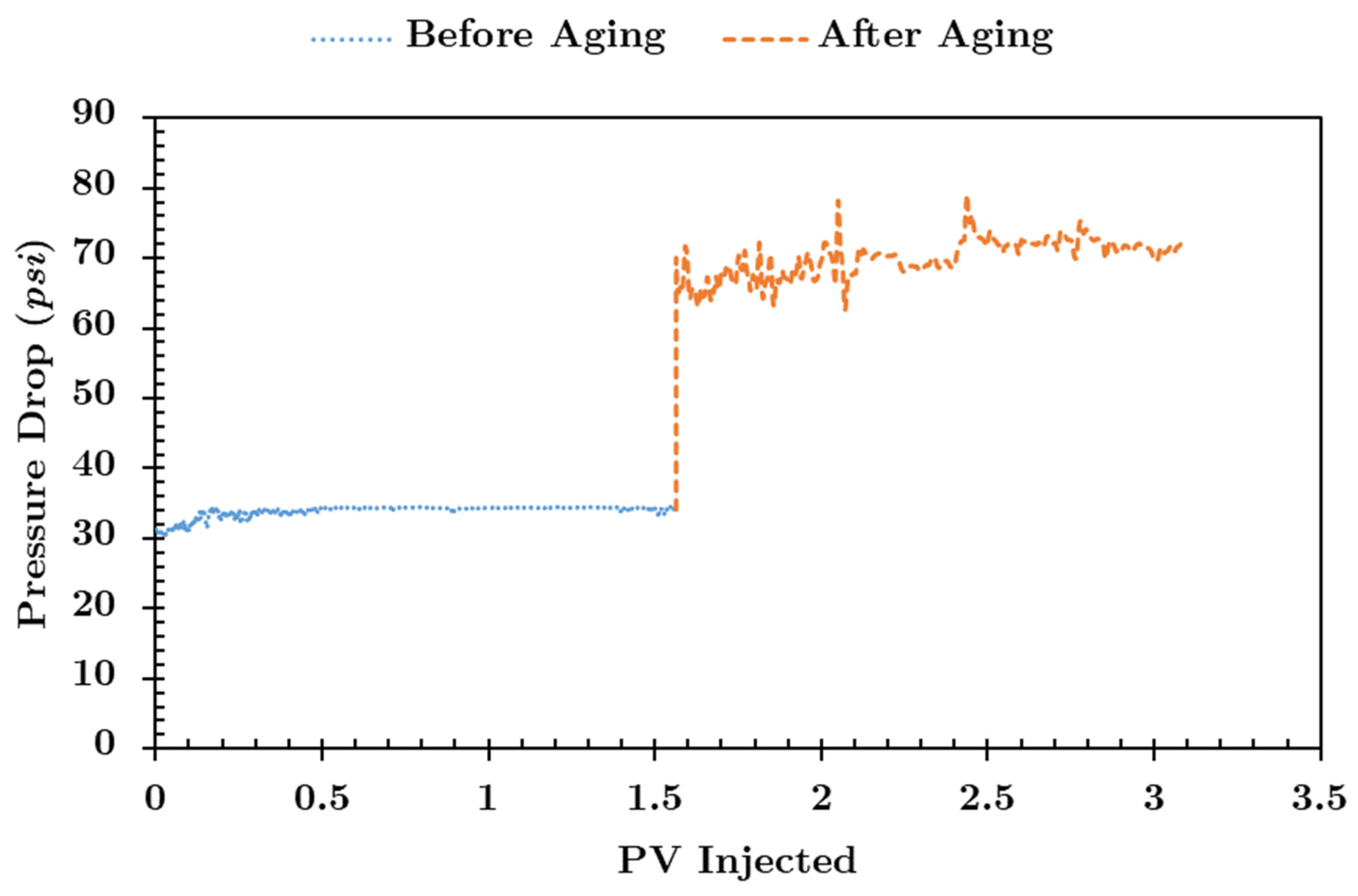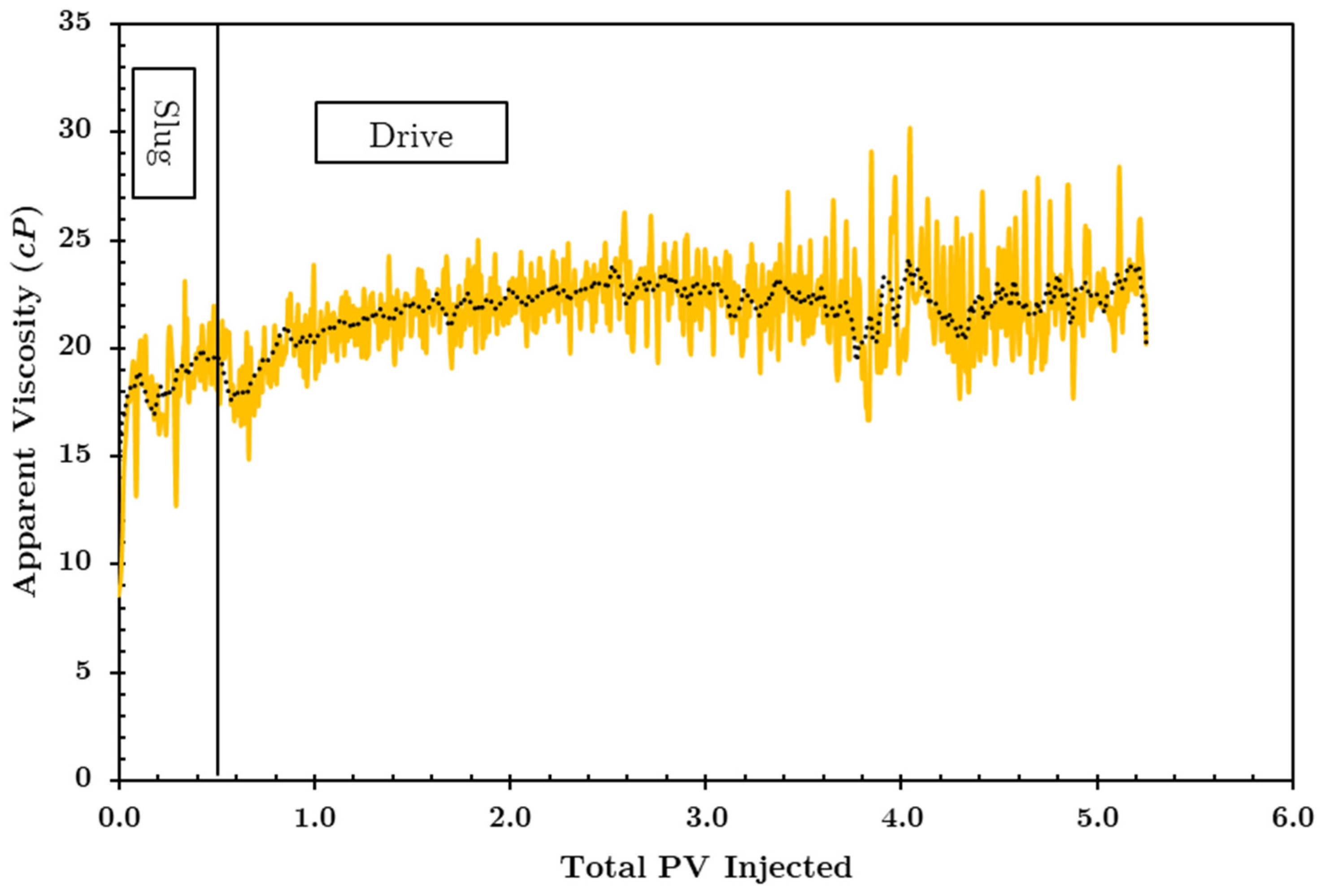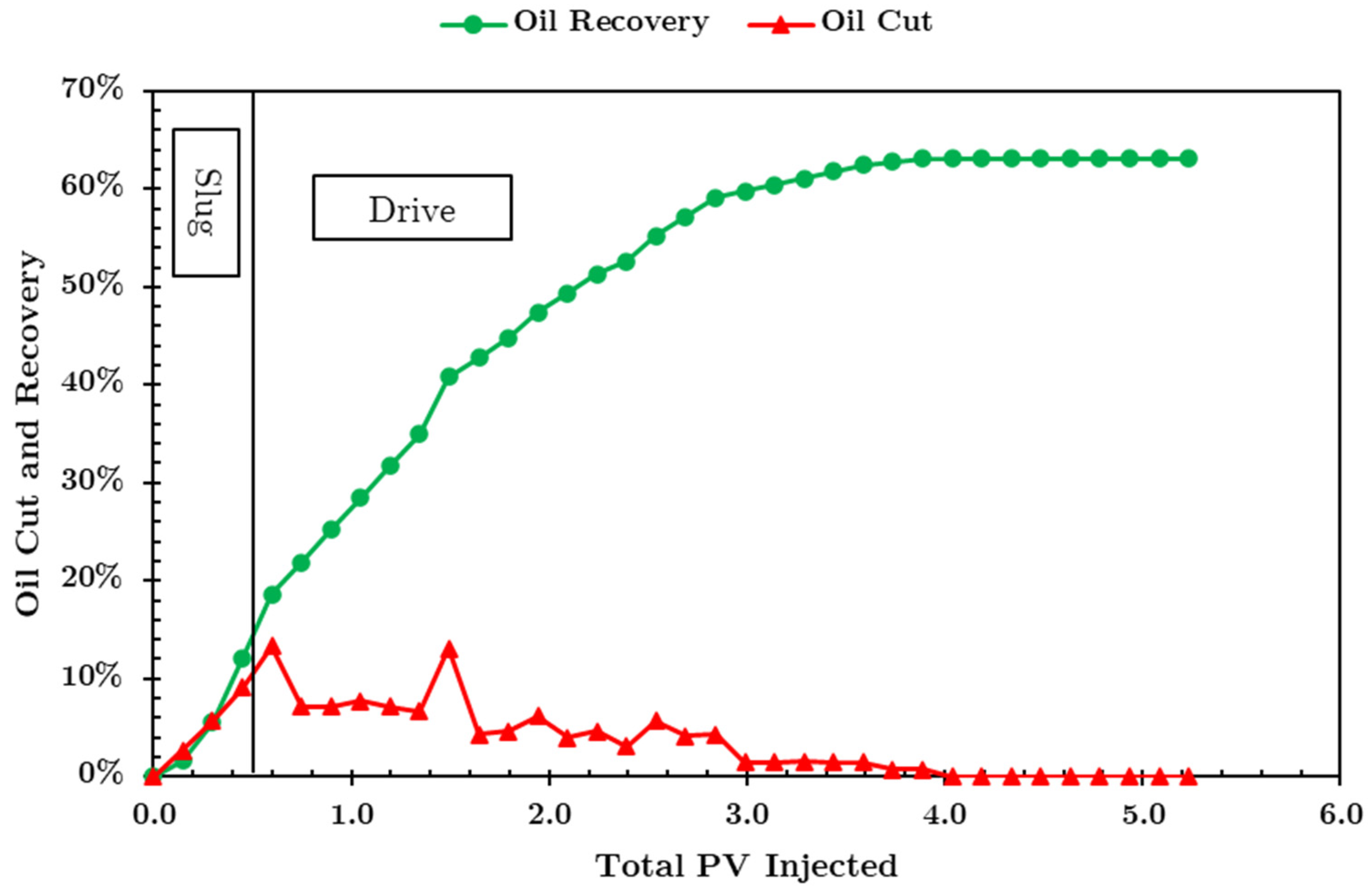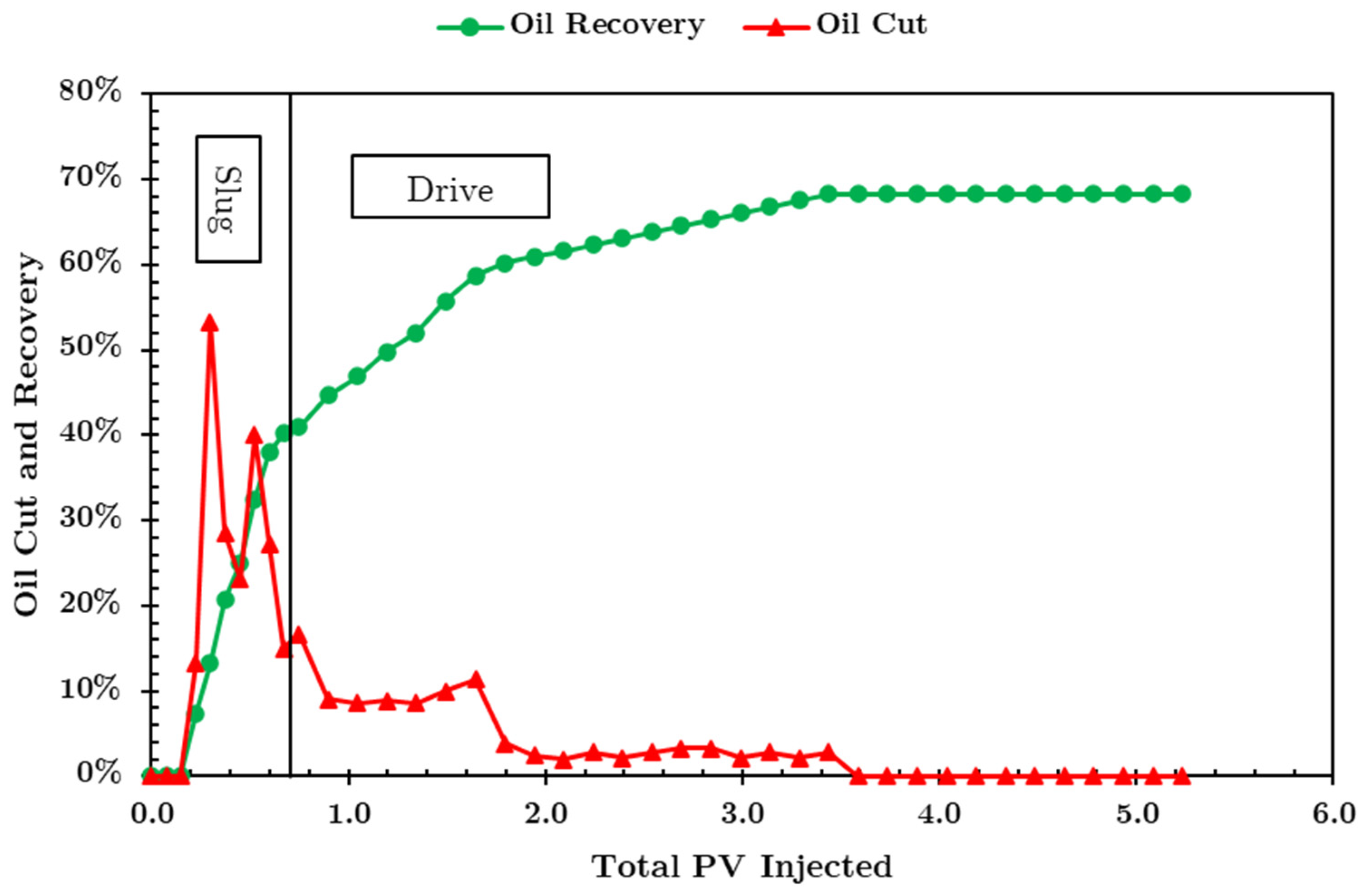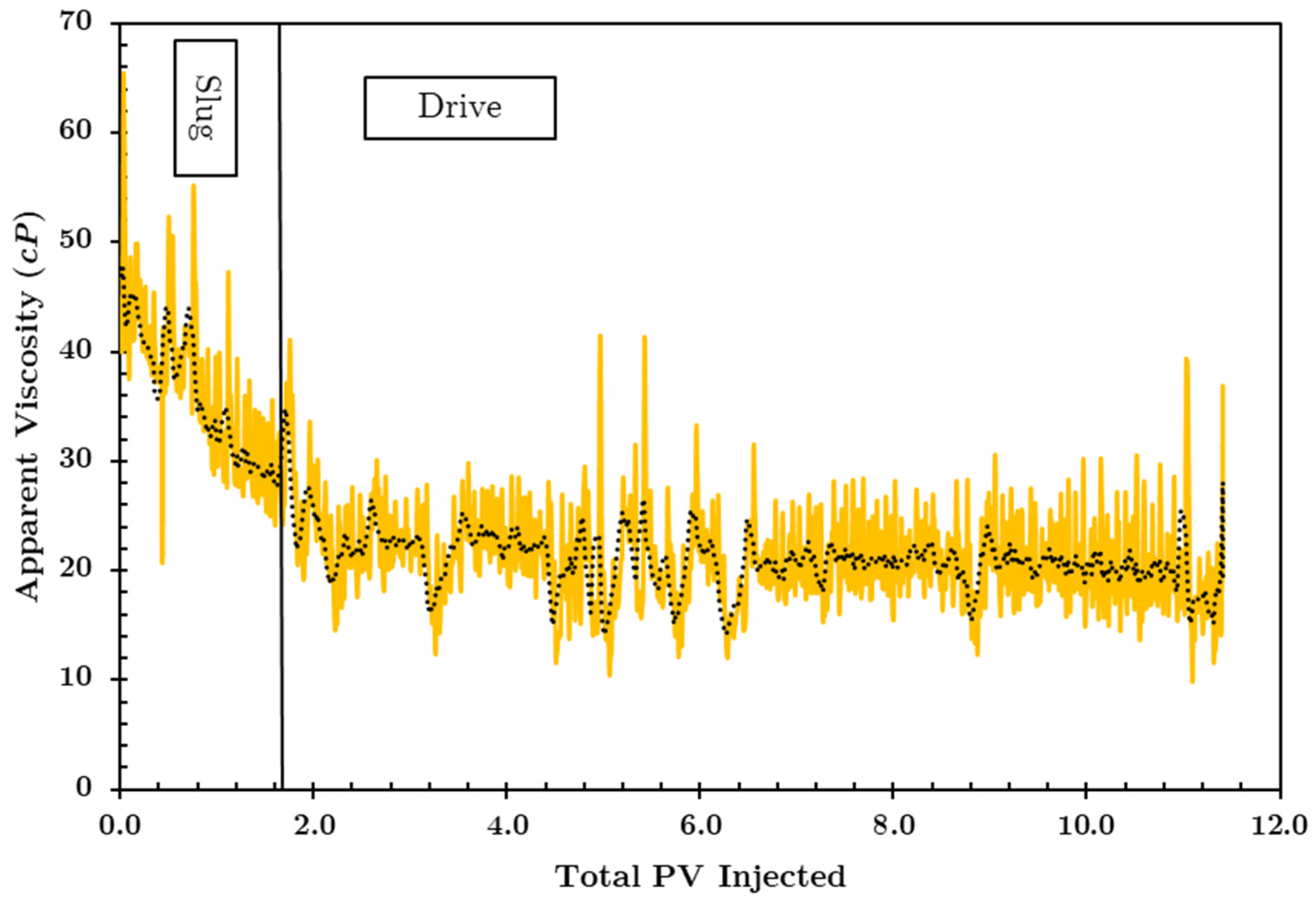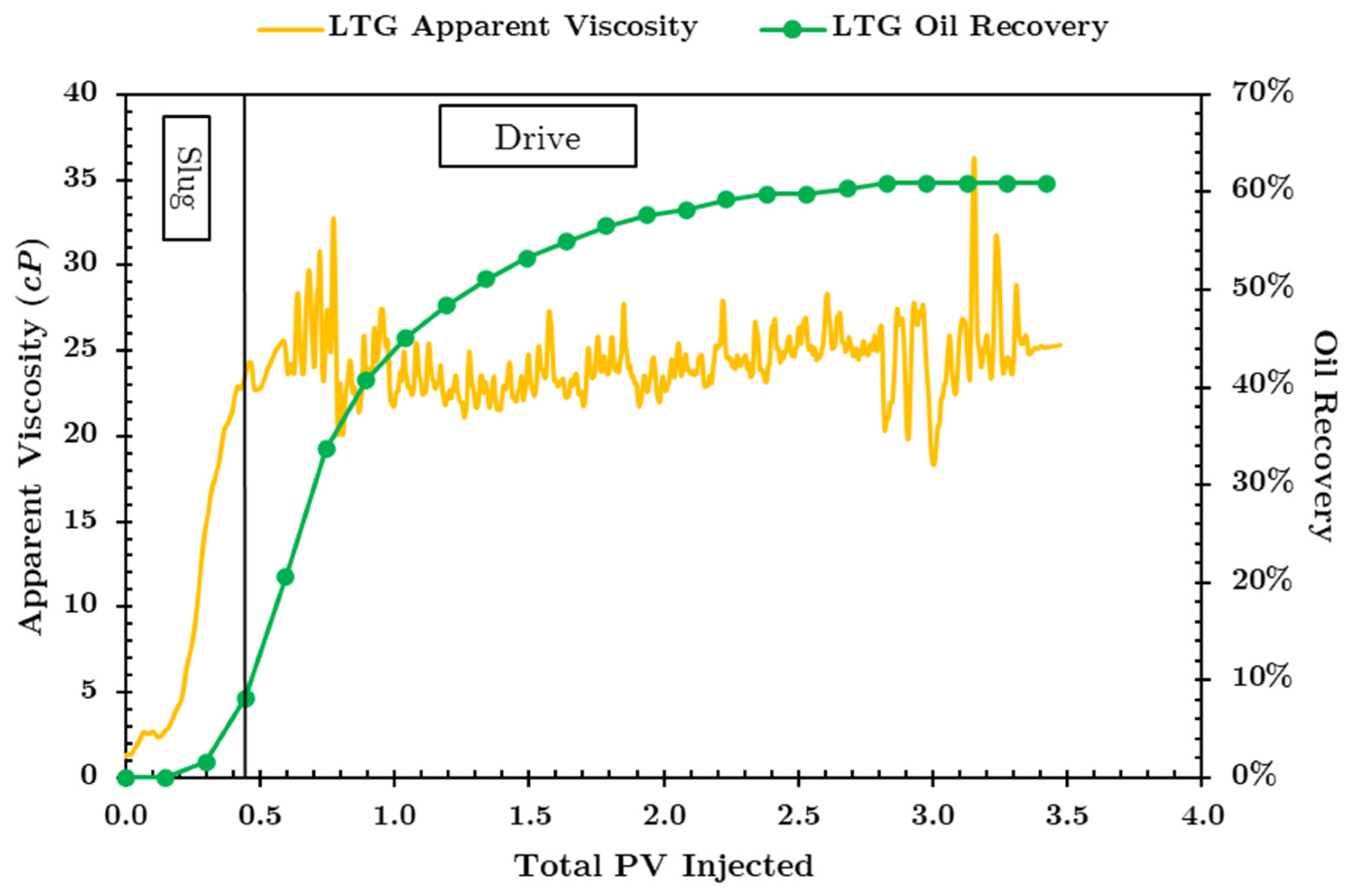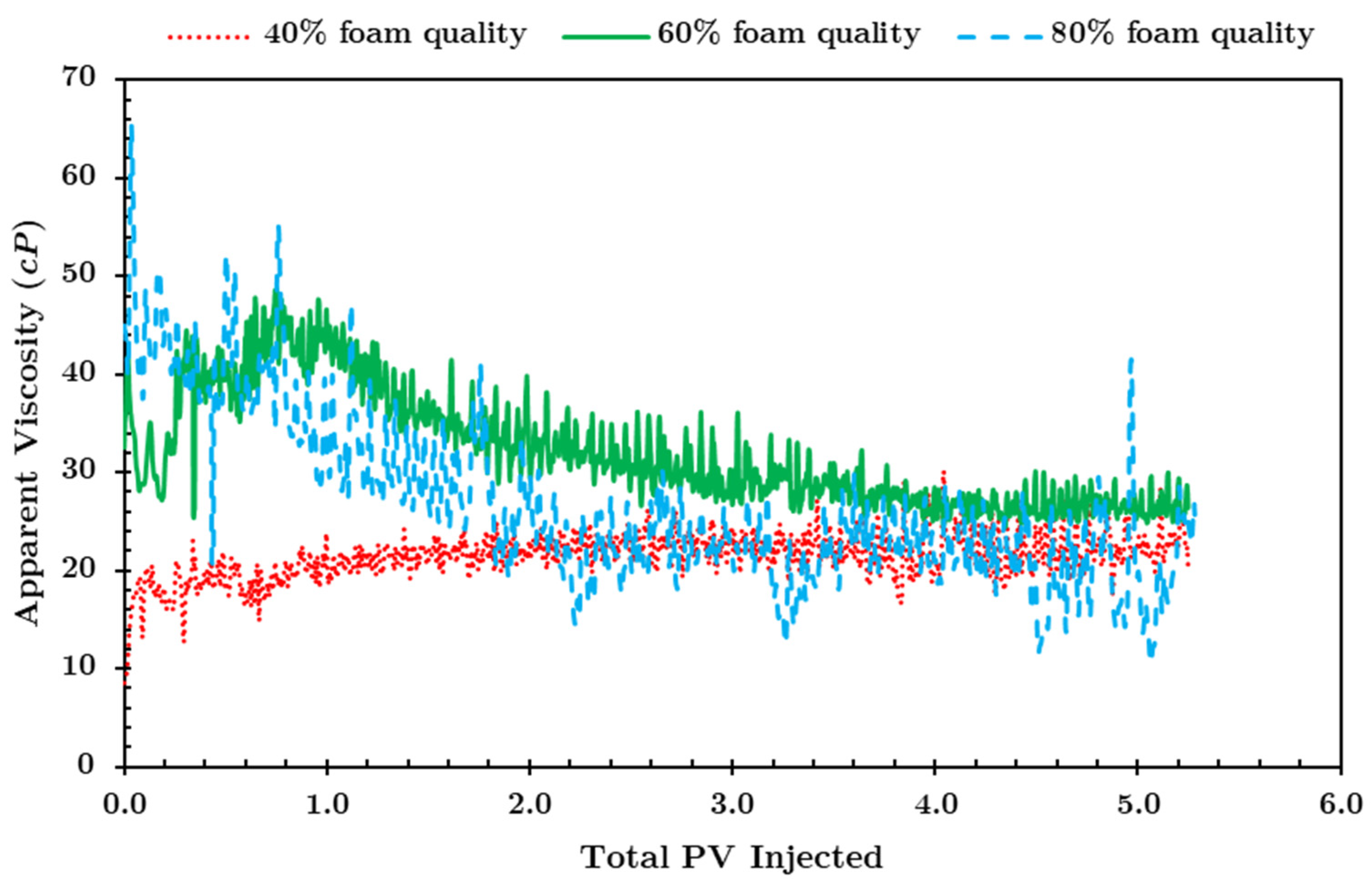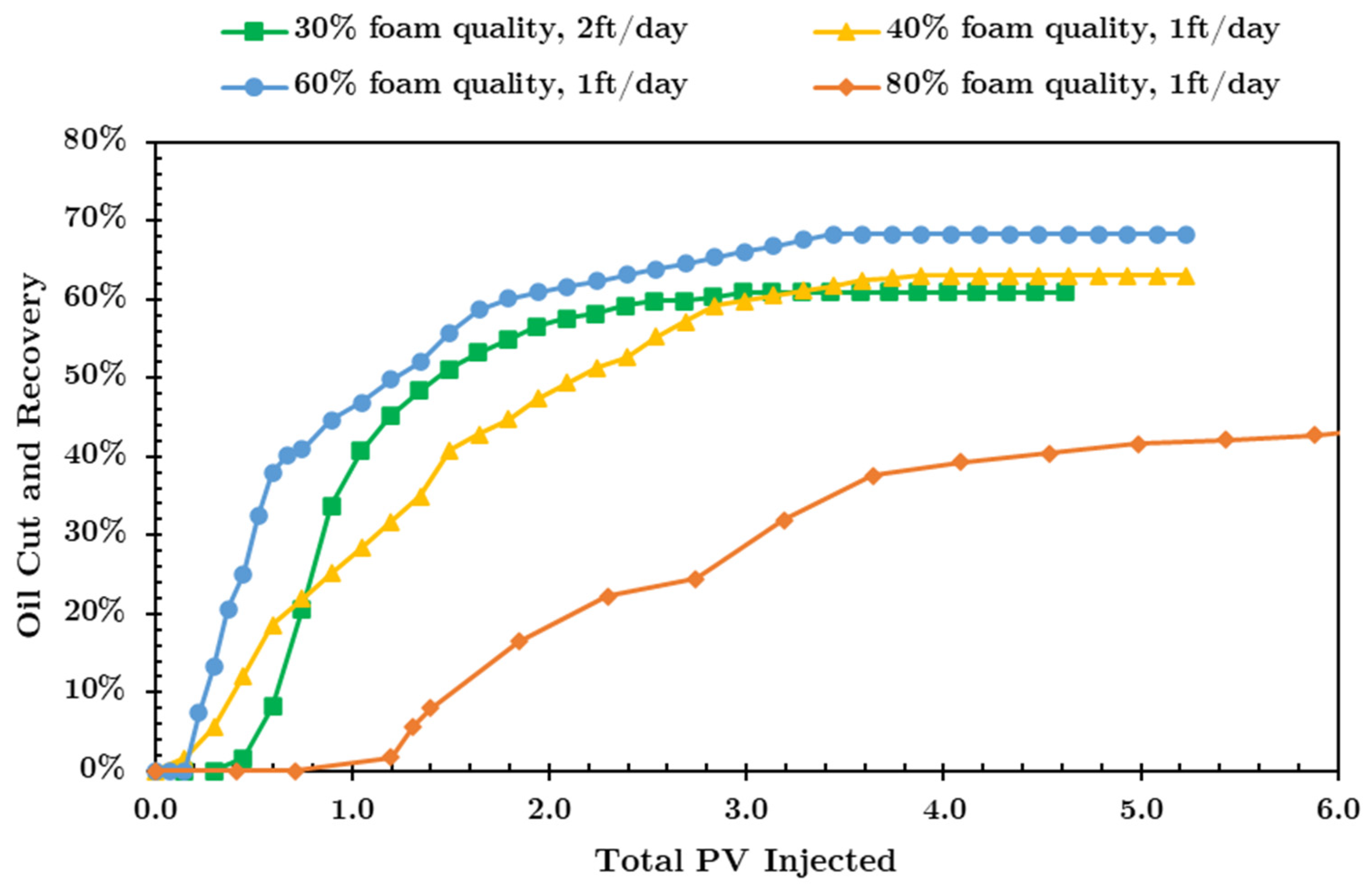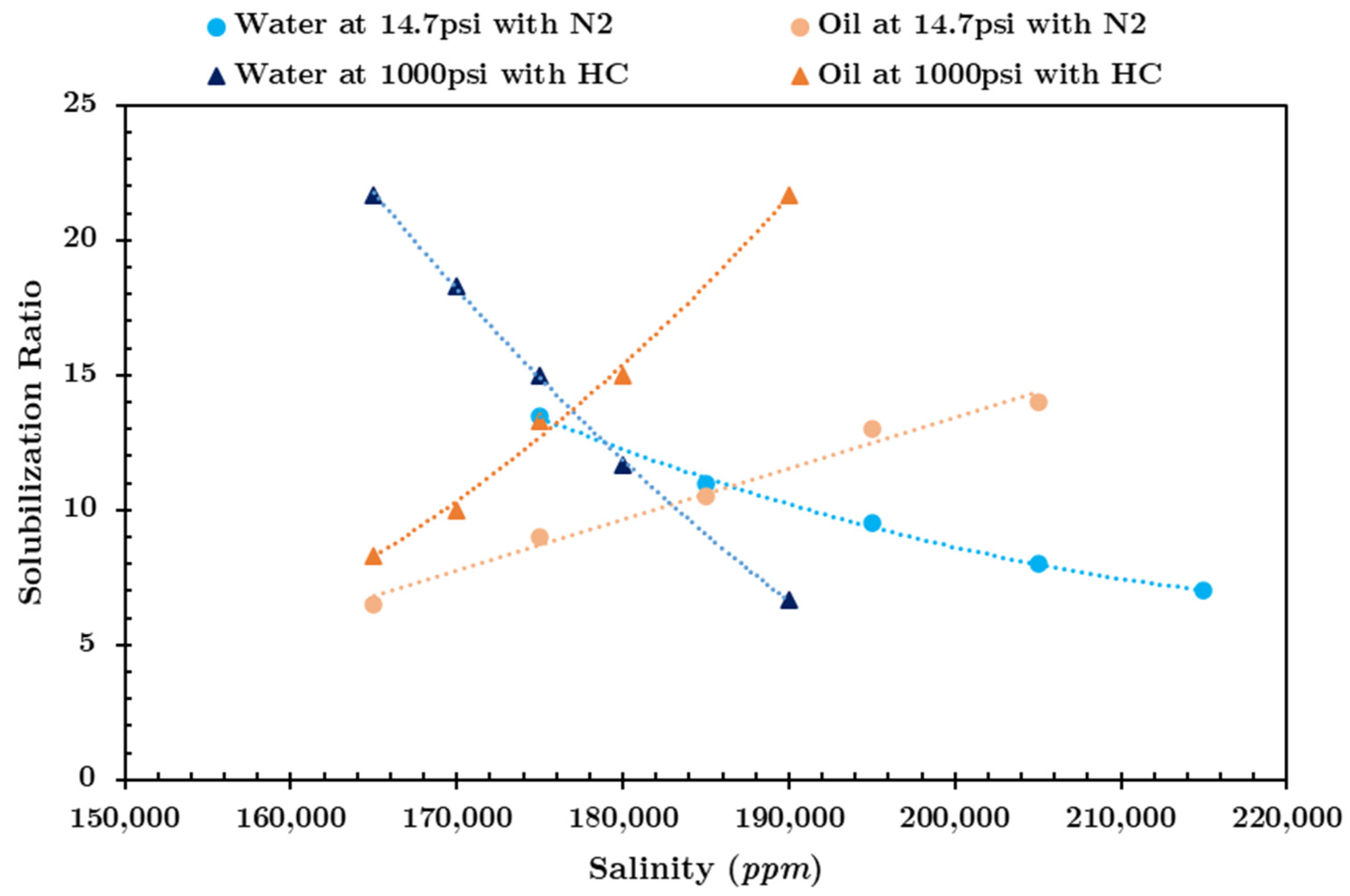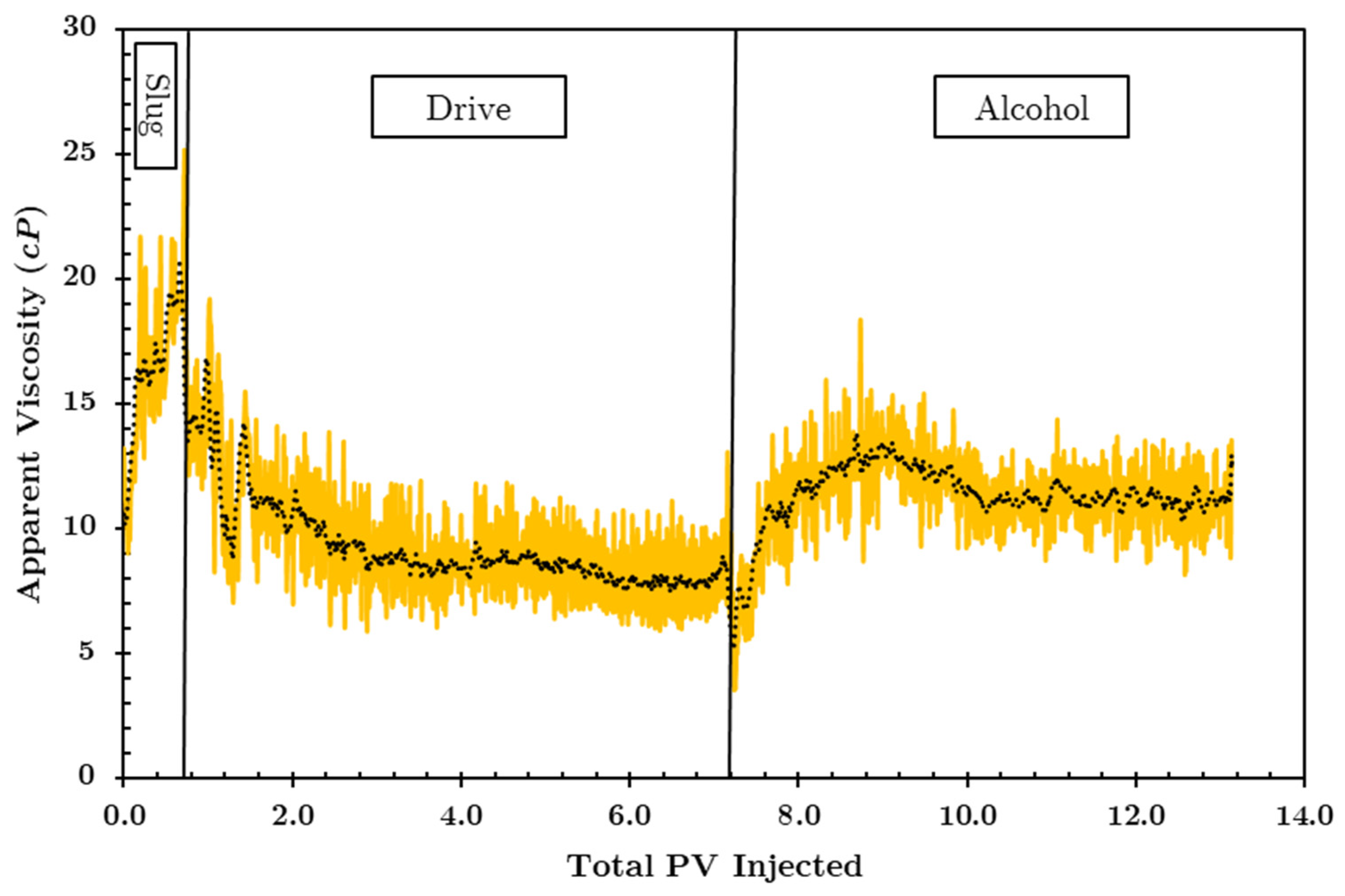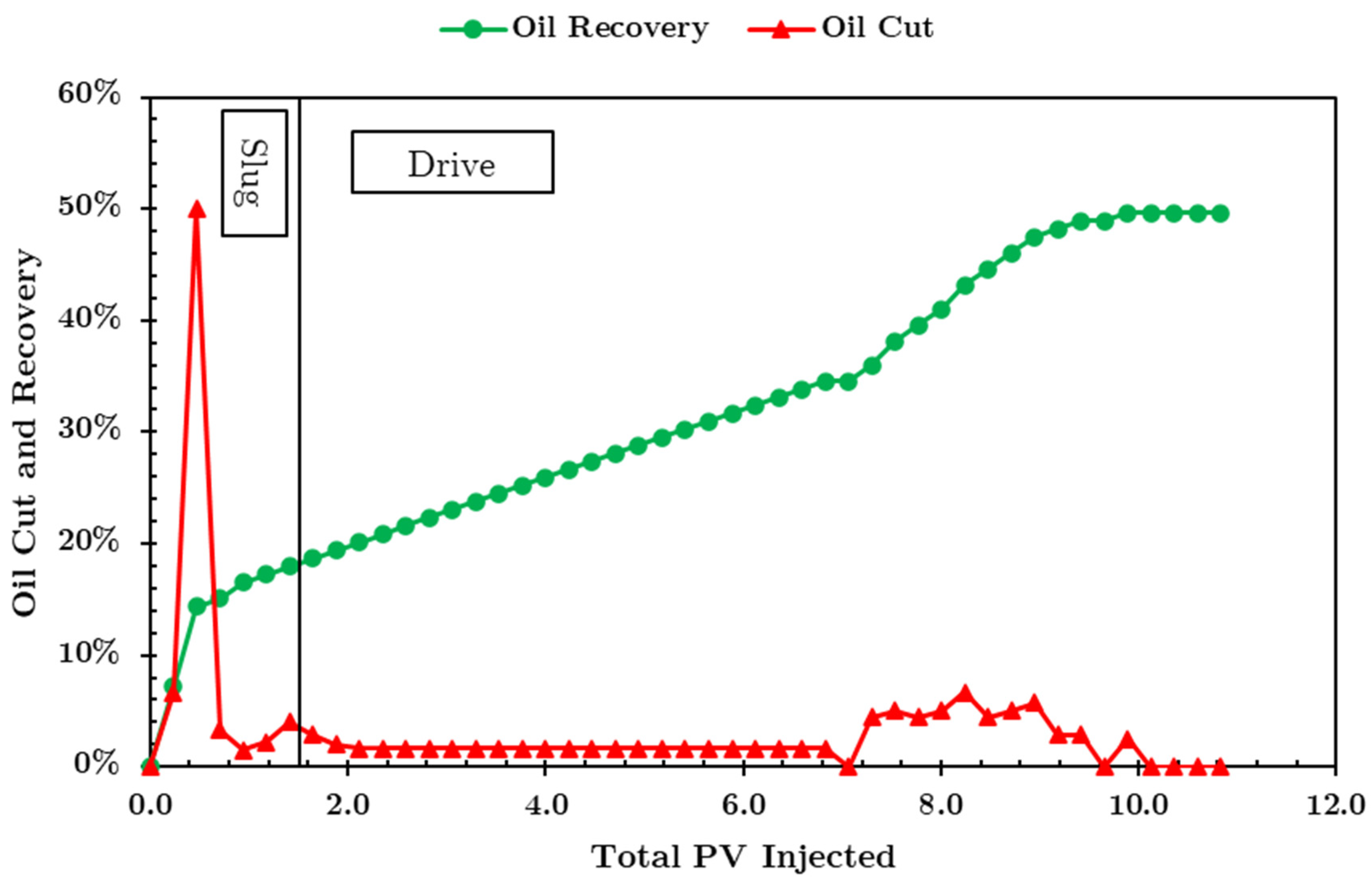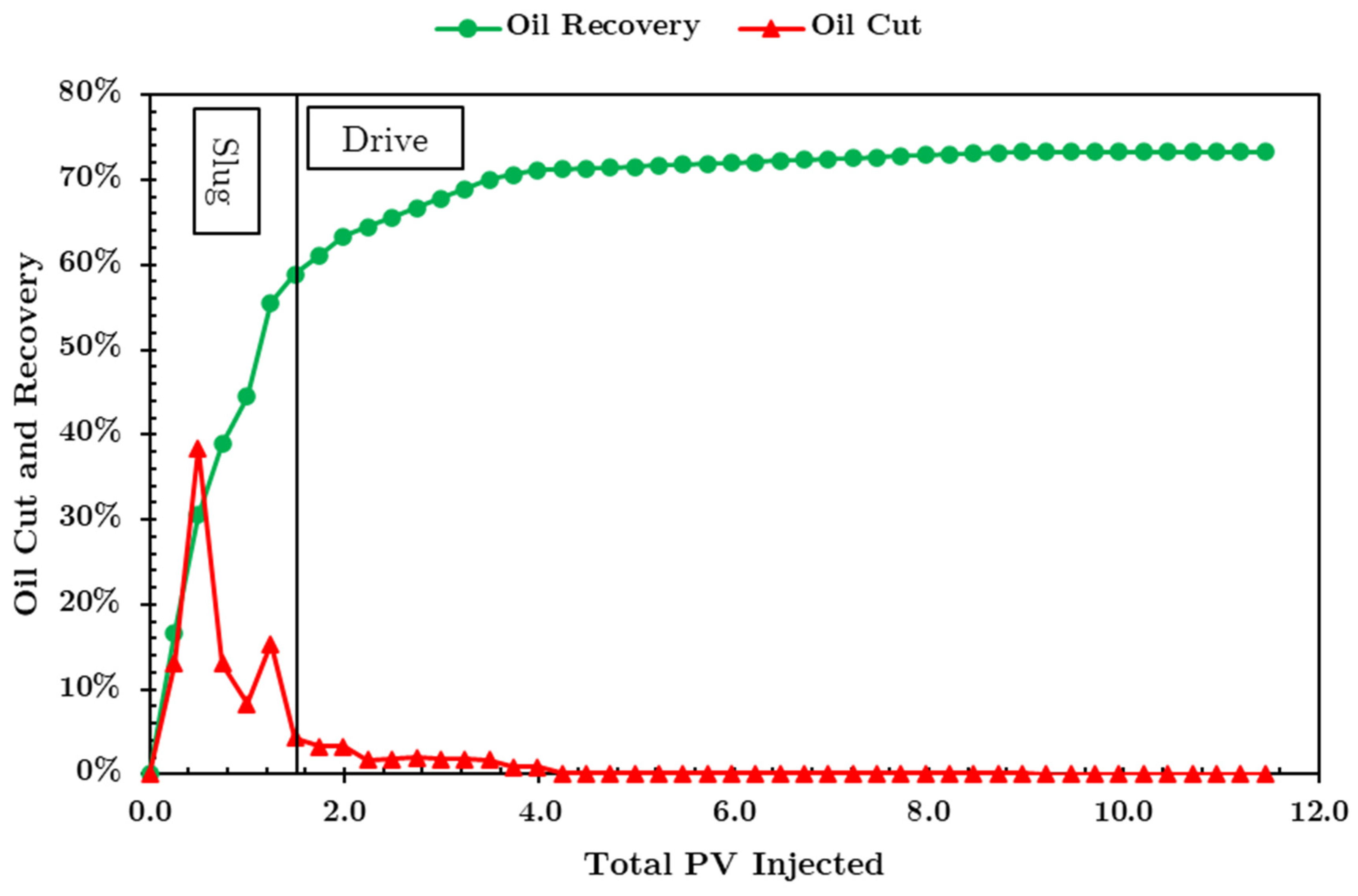3.1. Effect of Foam Quality in Oil-Wet Carbonates
Coreflood HC1. A waterflood was conducted at three increasing rates, 1, 3, and 10 ft/day, until residual oil saturation was reached. In this case,
Sorw was 23%, as shown in
Figure 3. Once there was zero oil cut in the effluent, the water injection rate was reduced back to 1 ft/day to obtain a baseline pressure drop measurement at
Sorw. This will be later compared to the late-time drive-pressure drop at
SorLTG. All hydrocarbon gas and nitrogen corefloods presented here follow this procedure.
For this coreflood, the LTG injection scheme consisted of 40% foam quality for both the slug and the drive, with the slug being 0.3 liquid PV (LPV). The injection rate was 1 ft/day to simulate far-field conditions. The apparent viscosity for this coreflood is shown in
Figure 4. For this and all subsequent figures, an average trendline is shown on top of the raw measured pressure data for easier reading.
When the slug initially encounters the trapped oil, the reduced IFT and enhanced mobility control due to foam mobilizes the oil, which eventually forms an oil bank. This explains the initial increase in apparent viscosity seen during the slug injection. During the drive injection, the apparent viscosity is nearly constant at around 23 cP, and oil cut is also somewhat constant at approximately 5%, as seen in
Figure 5. One would expect the viscosity to decrease as more oil is being produced. This is not observed here, and the steady-state apparent viscosity is significantly higher than that of the waterflood at the same rate. This can be attributed to two phenomena: the relative permeability effect of two-phase flow in low-permeability cores, and the generation of foam. The relative permeability of gas is greatly reduced due to gas trapping [
26], and this trapped gas affects the mobility of the flowing aqueous phase by reducing its saturation [
27]. This implies that for the same injection rate, a greater apparent viscosity is encountered. The apparent viscosity during the 10 ft/day waterflood stage reached a maximum value of 70 cP with no additional oil production, as seen in
Figure 3. Therefore, any oil production during the LTG stage is not attributed to viscous forces. Hence, the reduction in IFT in the early time period leads to oil mobilization, and the reduced mobility of the displacing fluids in the late time period results in the additional recovery after the waterflood.
Looking at the oil recovery within 1 PV of total (liquid and gas) injection, 28% ROIP was achieved, and an ultimate recovery of 63% ROIP was achieved after 4 PV of total fluids was injected. The low yet steady oil cut from breakthrough until about 3 PV injected indicates that the mobilized oil fraction in the oil bank is low, which is not desirable. It would be more attractive to generate an oil bank with a higher oil cut faster to produce more oil within the first pore volume of total injection fluids. The following corefloods will focus on improving the oil recovery rate within 1 PV of total injection.
Coreflood HC2. The second coreflood using the hydrocarbon gas mixture was conducted using 60% foam quality during the LTG flood. As before, the LTG flood was preceded by a waterflood, which achieved an
Sorw of about 20%. The same slug and drive compositions were injected at the same rate of 1 ft/day. The viscosity profile shown in
Figure 6 resembles a more traditional one, where there exists an initial increase in apparent viscosity due to the mobilization of the oil bank and then a gradual decrease as the oil is being produced to reach a stead value at
SorLTG.
The apparent viscosity maxed out at around 50 cP during the slug injection and reached a steady state value of 28 cP during the late time period of the drive. For this experiment, alcohol was injected after about 2.75 LPVs of drive. At that time, the apparent viscosity had been stable for more than 2 PVs and there was no more oil production. Single-phase injection of alcohol was observed to rapidly destabilize foam and decrease the apparent viscosity [
11]. However, in this coreflood, the alcohol was co-injected with the hydrocarbon gas at the same gas quality as the drive, 60% in this case. The purpose behind this was to decouple the effect of foam and relative permeability reduction due to the two-phase flow in the low-permeability core. As mentioned [before, the presence of trapped gas saturation decreases the relative permeability of the injected fluids, resulting in a higher observed apparent viscosity. To eliminate the foam and maintain the two-phase flow effect, alcohol was injected at the same rate and gas quality. As can be seen in
Figure 6, there is a very slow decreasing trend in the overall apparent viscosity across the core down to 25 cP, as opposed to a rapid reduction compared to single-phase alcohol injection [
11]. The slight decrease in viscosity indicates that the foam, while present, is not very strong. It also implies that proper mobility control is still achievable in low-permeability oil-wet carbonates despite the lack of strong foam.
Looking at the ultimate oil recovery and recovery rate in
Figure 7, it is clear that a much more substantial oil bank was formed as compared to
Coreflood HC1 with 40% gas quality. About 50% ROIP was achieved within 1 PV of total injected fluids, and
SorLTG is close to 70%. This coreflood shows much better mobility control, as evident by the large oil cut in the beginning, as well as sustained oil production until around 1.5 total PV injected. An added explanation is that the presence of more gas in the system in general is beneficial for the formation of Type III microemulsions in the core as it increases the solubilization of oil [
24]. Phase behavior experiments showed that the optimal salinity for the live oil at 1000 psi is 179,000 ppm TDS. The dead crude oil was allowed to reach equilibrium with the hydrocarbon gas mixture at that elevated pressure in the microemulsion phase behavior experiments, whereas, in these coreflood experiments, the injected gas and slug solution come into contact with dead oil in the core. It follows then that the increased gas quality leads to more gas being absorbed into the dead oil, not only causing it to swell and reducing its viscosity (which also helps in improving recovery rate) but also allowing it to form Type III microemulsions more readily when compared to the 40% gas quality case. It must also be noted that the LTG flood in
Coreflood HC2 started with 3% lower
Sorw compared to
Coreflood HC1 but showed a higher oil recovery, 68% compared to 63%, making the benefits of the 60% gas quality and microemulsion formation even more significant.
Coreflood HC3. This third experiment using the hydrocarbon gas mixture was performed at 80% gas quality. The waterflood preceding the LTG flood resulted in a
Sorw of about 26%. The viscosity profile of this coreflood, as shown in
Figure 8, does not show the initial increase during the slug as seen in the previous two experiments. This may be attributed to the higher
Sorw as compared to the previous two experiments. To better understand this observation, further analysis needs to be performed on the oil recovery data.
Looking at
Figure 9, it is apparent that the recovery rate is poor. There was barely any oil production within 1 PV, and the ultimate recovery only reached 51% ROIP. At around 1.2 PVs in total injected, the oil cut increases significantly and is sustained for around 2 PVs. Converting total PVs injected into liquid PVs injected with 80% gas quality gives about 0.25 PVs of liquid injected, which is only slightly smaller than the designed slug size. This is important because it means that the total amount of desired surfactant (0.3 LPV) will take longer to be fully injected. Therefore, at the same given moment, there is less volume of surfactant in the core to form Type III microemulsions and reduce IFT as compared to the previous corefloods. Looking just at the total PVs injected will give an overly pessimistic interpretation because there is so much gas being injected at 80% gas quality that it takes 1.5 PVs of total injection just to inject the entire 0.3 LPV slug. However, this does have a positive side effect: the presence of more gas in the core at the higher gas quality means there is more gas available for the oil to absorb, swell, and become less viscous and more mobile. This is evident by a large oil cut at breakthrough. It can be said that the oil recovery of this experiment is comparable to that of
Coreflood HC2 but delayed due the increased amount of gas being co-injected. Unfortunately, this is still undesirable economically, making the produced oil bank too late to matter in any field application.
An additional coreflood was performed with the intent to determine the effect of the injection rate on the steady-state apparent foam viscosity as well as oil recovery in low-permeability oil-wet carbonates. For this purpose, a core with similar properties was used, with all other injection parameters being the same as the previous corefloods expect the injection flow rate and foam quality. The rate was doubled to 2 ft/day and the foam quality was further reduced to 30%. This means that the 0.3 LPV slug would be delivered faster. The apparent viscosity and oil recovery results are shown in
Figure 10.
The apparent viscosity initially increased then stabilized at around 23 cP, comparable to the corefloods conducted at the lower rate. Looking at the oil recovery, ROIP reached around 40% within the first PV of total injected fluids, similar to Coreflood HC2, and the total oil recovery reached above 60% ROIP after about 3 PV of total injected fluids, slightly less than Coreflood HC2. The increase in injection rate and decrease in injection foam quality did not significantly affect oil production or mobility control. This coreflood shows that it is possible to reduce the injection rate by half (from 2 ft/day to 1 ft/day) and still maintain both proper mobility control and economically attractive oil recovery rates within 1 PV of total injection, as seen in Corefloods HC1-HC3.
Figure 11 shows the viscosity profile of the three hydrocarbon corefloods. Looking at the early time period,
Coreflood HC1 at 40% foam quality had a long and thin oil bank, as seen from the oil cut in
Figure 5, which would explain the lack of a typically observed increase then decrease in apparent viscosity indicative of the mobilization of a significant oil bank. Increasing the foam quality to 60% in
Coreflood HC2 resulted in a thicker oil bank, which explains the initial increase in viscosity. Once the oil broke through and oil saturation decreased significantly, the viscosity also started to decrease.
Coreflood HC3 at 80% foam quality started at a higher viscosity than
Coreflood HC1 or
Coreflood HC2. This can be attributed to the fact that the initial oil saturation for LTG (
Sorw) is higher for
Coreflood HC3 (26%) than for
Coreflood HC1 (23%) or
Coreflood HC2 (20%). This means that the injected fluids are encountering a larger volume of immobile oil after the waterflood. Another explanation is that the in situ gas saturation at 80% foam quality is higher than that for the two other cases (35% as opposed to 25%), which causes a greater reduction in the total mobility of the injected fluids [
21], thus increasing the measured apparent viscosity.
Looking at the late-time apparent viscosities, the three tested foam qualities (40–60–80%) show the same average value. This shows that there is no significant change in foam behavior in low-permeability oil-wet carbonates under these conditions. Early work has shown that surfactant adsorption in oil-wet cores can be significant and leads to weaker foam generation [
28]. For all experiments, the apparent viscosity during the late-time drive was significantly higher than during the waterflood at
Sorw. Oil is produced during the slug propagation through the core, so the residual oil at the late time period of the drive is lower than that of the late-time waterflood. Based on this, a lower apparent viscosity is expected across the core provided the same injection conditions are maintained. However, in all of the HC experiments, there is a significantly higher apparent viscosity even at the lower oil saturations. This can be attributed to two factors: relative permeability effects due to two-phase gas–water flow that leads to a decrease in fluid mobility, and generation of foam during the drive injection, which increases the trapped gas saturation and increases the effective gas phase viscosity [
29]. Alcohol and gas co-injection, which destabilized foam, showed only a small decrease in the apparent viscosity after the drive, leading to the conclusion that proper mobility control can still be achieved in low-permeability oil-wet carbonates during two-phase flow even in the absence of strong foam.
Looking at the oil recoveries in
Figure 12, it is clear that the 80% case is the worst while the 60% case is the best, even when compared to the 30% case at 2 ft/day. This is from the perspective of the oil recovery at 1 PV of total injection, but it is also true for the ultimate recovery. Given that the injection gas was 85–15% methane–ethane, there will be some level of interaction between the gas and the dead oil in the core. When hydrocarbon gas comes into contact with the oil, some of it dissolves in the oil, causing it to swell. This will decrease the viscosity of the oil, allowing it to flow more easily. Additionally, the hydrocarbon gas will increase the solubilization ratio in the presence of the slug surfactant [
24]. All of these factors lead to an increase in oil production.
For the case of 80% foam quality, we expect the large amount of gas present to cause a significant amount of interaction with the oil, leading to a higher recovery rate. This was not the case, however. Despite the relatively large oil bank seen in the oil cut in
Figure 9, which indicates a significant amount of oil swelling, reduced oil viscosity and oil mobilization, the oil breakthrough was much later compared to
Coreflood HC1 and
Coreflood HC2. It is important to note that at 80% injection foam quality, only 20% of the first PV injected is liquid surfactant. The entire slug is 0.3 LPV, meaning that by the time 1 PV of total injection was reached, only 67% of the slug had been injected. This would also contribute to the poor oil recovery at 1 PV of total injected fluid, since not all the desired amount of surfactant in the slug was injected [
30].
For the case of 60% foam, around 50% oil recovery was achieved within 1 PV of total injected fluid. It also achieved the highest ultimate recovery, around 68% ROIP. It is hypothesized that this foam quality led to favorable interaction between the oil and the gas, including oil swelling, viscosity reduction, and an increased solubilization ratio, all of which contribute to the good oil recovery. This can also be seen from the viscosity profile: there seems to be a relatively substantial mobile oil bank as compared to the 40% case.
Comparing the lower injection rate experiments
Coreflood HC1,
HC2 and
HC3 to the reference coreflood in
Figure 12 shows that reducing the rate does not negatively impact mobility control, as seen by the comparable apparent viscosities. Also,
Coreflood HC2 at 60% foam quality was able to achieve a better oil recovery rate: 50% ROIP vs. 40% ROIP at 1 PV of total injection. Thus, the lower rate coreflood was successful in the following aspects: (i) mobility control was still maintained and (ii) oil recovery within 1 PV was acceptable.
A major component in LTG floods is IFT reduction. This is achieved by creating a Type III microemulsion environment in the core at optimum salinity in the presence of oil, water, gas, and surfactant. This optimum salinity is affected by the oil composition, which would be different based on the type of gas used. Work carried out early on showed that adding methane to dead crude oil decreases the optimum salinity and increases the solubilization ratio [
31]. Similar studies show that ethane also has the effect of reducing the optimum salinity [
24,
32]. It is also noted that the type of gas influences the achieved foam strength at different foam qualities [
33]. Although it is more convenient to use available on-site produced hydrocarbon gas for LTG injection, it is still important to evaluate the effect of dissolved hydrocarbon gas on microemulsion formation in low-permeability oil-wet carbonate cores. It has been observed that there is no significant difference in steady-state foam strength between methane and nitrogen [
34]. To that effect, the hydrocarbon gas mixture was replaced with nitrogen, which is not oil soluble. This will eliminate any of the positive interactions that the hydrocarbon gas has with the oil in terms of oil swelling and viscosity reduction, and most importantly, microemulsion behavior. As can be seen in
Figure 13, the optimum salinity using nitrogen with the surfactant slug is around 186,000 ppm at atmospheric pressure and 69 °C. Increasing the pressure to 1000 psi has no effect on optimum salinity. The optimum salinity for the methane–ethane mixture is slightly lower at 179,000 ppm at the elevated pressure. The solubilization ratio using nitrogen was around 11 and does not change with higher pressure, while that of the HC mixture was higher at 14. This agrees with previous work showing that using hydrocarbon gas instead of nitrogen lowers the optimum salinity and increases the solubilization ratio [
24]. An increase in the solubilization ratio results in further IFT reduction and, thus, oil recovery improvement.
3.2. Effect of Gas Type and Salinity Shift on LTG Performance
Based on the observation that 60% foam quality was the best in oil-wet carbonates with low permeability in terms of the oil recovery rate and ultimate recovery, the next two experiments focused on the importance of the type of gas injected on oil recovery during LTG in terms of solubility and Type III salinity shift.
Coreflood N1. This first experiment was conducted at 179,000 ppm with nitrogen. This effectively eliminates the HC gas-oil interactions given the drastically reduced solubility of nitrogen in the dead crude oil. This means that any production that occurs can mainly be attributed to a reduction in IFT through the formation of Type III microemulsions.
Figure 13 suggests that injecting nitrogen at 179,000 ppm is right at the border of Type I and Type III microemulsion formation.
The viscosity profile in
Figure 14 shows the same trend of an initial increase then gradual decrease as oil is being produced during the slug to reach steady state at the late-time drive. The average apparent viscosity during the late-time drive was about 9 cP. This is lower than the three HC gas experiments where the apparent viscosity was around 25 cP, but it is still higher than the waterflood at the same injection rate. Again, at lower oil saturation (
Sorw = 21% vs.
SorLTG = 14%), one would expect a lower apparent viscosity. This was not the case, however, due to the reduction in the mobility of the injected fluids and the generation of foam.
Figure 15 shows that there is no substantial oil production before 7 PV injected. This means that the remaining oil saturation in the core is higher during the late-time drive injection (
SorLTG = 35%).
Several studies have shown that there is a detrimental effect on foam performance with increasing oil saturation, with various theories on the mechanisms behind it [
35]. As a specific example, one study in aged cores showed that for field gas, methane, and nitrogen, foam strength decreased from around 1000 cP to only 200 cP as oil saturation increased from 13% to 19% [
36]. Unstable foam would lead to comparatively lower apparent viscosities [
37,
38]. Additionally, the in situ gas saturation during the coreflood was measured to be only 13%, compared to the HC corefloods where the gas saturation was around 25–35%. This reduced gas saturation leads to a smaller reduction in fluid mobilities, which explains the lower apparent viscosities measured in this coreflood. Therefore, the slow recovery and low oil cut shown within the first 7 PVs can be attributed to poor mobility control due to the presence of higher oil saturation and lower gas saturation, which resulted in lower apparent viscosities during the drive injection.
Injection of alcohol after the APG drive at the same gas quality showed the effluent with very clear Type I microemulsion being produced. The alcohol mobilized the microemulsions that were not produced while the APG was being injected, which led the oil recovery to increase substantially from 35% ROIP to the drive injection up to 50% ROIP. The alcohol injection salinity was much lower than the lower salinity limit of Type III microemulsion formation, so the in situ salinity of 179,000 ppm became diluted. At this reduced salinity, Type III microemulsions turn into Type I microemulsion, where there is oil in the aqueous phase with an excess oil phase [
39,
40]. The reason we observe the production of this microemulsion is due to the relatively high oil saturation remaining inside the core after about 7 PVs of injection. There is more oil available to be mobilized in
Coreflood N1 (
SorLTG = 14%) as opposed to
Coreflood HC2 where alcohol injection was also performed (
SorLTG = 7%), which explains why there was oil production in the former but not in the latter. The viscosity profile during alcohol injection is representative of a secondary oil bank being mobilized through the core.
This shows that replacing the HC gas mixture with nitrogen has a negative effect on both the oil production rate and ultimate oil recovery, the reason being that the nitrogen gas does not significantly absorb into the oil, thus having no effect on the oil volume (swelling) or its viscosity. An added factor is the fact that the surfactant injection salinity was at 179,000 ppm instead of the optimum salinity of nitrogen at those conditions of 186,000 ppm. This highlights the importance of having optimum Type III microemulsion conditions to reduce IFT to ultra-low values in LTG floods, which is further investigated in the next coreflood.
Coreflood N2. This experiment serves to show the importance of accounting for the shift in optimum salinity based on the gas type on the oil recovery and recovery rate. It maintained the same conditions as
Coreflood N1 except that the LTG flood was conducted at the optimum salinity of nitrogen, which is 186,000 ppm using this surfactant formulation, re-introducing ultra-low IFT conditions in the core, while still eliminating the effect of the HC gas mixture on the oil.
Figure 16 shows an initial increase in apparent viscosity during the slug injection, indicating the mobilization of a large oil bank. As that oil is being produced, the viscosity decreases until it reaches a steady state at around 8 cP. This is the lowest late-time drive injection apparent viscosity seen in these experiments. This can be attributed to the lowest remaining oil saturation during that injection step: 5%. Alcohol was co-injected at 60% gas quality after about 3.5 LPV injection (8.8 total PV). As can be seen from
Figure 16, the apparent viscosity decreased from 8 cP to about 5 cP, indicating that foam was present and is being destabilized by the alcohol. The stabilization of the pressure drop after this decrease is an indication of the relative permeability effect. The remaining gas saturation in the core reduces the mobility of the injected fluids, resulting in an apparent viscosity greater than that of the waterflood at the same injection rate, despite the significantly lower oil saturation.
The oil recovery data are shown in
Figure 17. Within 1 PV of total injection fluids, ROIP reached 50%, with relatively high oil cut. This elevated recovery rate as compared to
Coreflood N1 correlates with the nitrogen optimum salinity, leading to better Type III microemulsion formation. Although the oil cut was extremely low after about 2 PV injected, the ultimate oil recovery reached 72%. This indicates that most of the oil is mobilized during the slug injection because of the reduced IFT, and in the early drive injection time as the foam provides good mobility control for that mobilized oil. This is the most desirable result as most of the oil is produced within 1 PV of total injection.
Figure 18 shows the oil recoveries of the best HC experiment,
Coreflood HC2, compared against the two nitrogen experiments,
Coreflood N1 and
Coreflood N2. The dominant effect of IFT reduction is apparent. In
Coreflood N1, the LTG flood was conducted at 179,000 ppm, which is not the optimum salinity of nitrogen where oil and water solubilize equally in the Type III microemulsion phase. This led to a poor recovery rate as well as poor ultimate recovery when compared to the two other experiments.
Coreflood HC2 and
Coreflood N2 were conducted at the respective optimum salinity of the methane–ethane mixture and nitrogen. Both resulted in around 50% ROIP within 1 PV injected, with
Coreflood N2 having a slightly higher ultimate oil recovery after about 4 PV injected. These results show that it is possible to apply LTG as a tertiary recovery technique in low-permeability oil-wet carbonates and be economically attractive in terms of the oil recovery rate as well as ultimate oil recovery. Also, the results indicate that under the conditions present here, changing gas type from a HC gas mixture to nitrogen does not negatively affect the performance provided the gas is injected at its optimum salinity.

